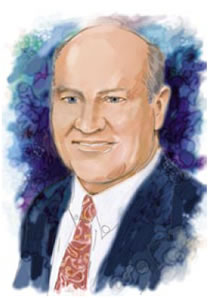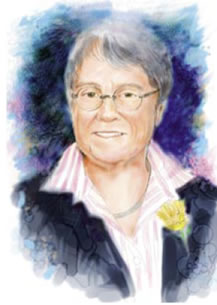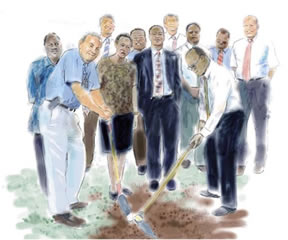
Vol. 14 No. 3 |
Winter 2004-05 |

Sans his trademark beard and clad in red plaid shirt and khakis, he speaks animatedly about the recent International AIDS Conference in Bangkok. Publicity about the event centered on the bickering between supporters and critics of the Bush administration’s policy in fighting global AIDS, but Sande wants to focus on positive developments. "We now have drugs that, if taken early enough, can make all the difference for many patients," he says, noting that there are pharmaceutical companies that have expressed willingness to donate drugs for clinical trials.
Sande, director of the University of Utah School of Medicine’s residency program for internal medicine, wears many hats—doctor, professor, researcher, textbook author, editor of the best-selling medical textbook The Sandford Guide, and foundation president—but AIDS is his metier. In fact, Sande is world-renowned for his work in AIDS. But if you listen to him talk about his career, you’d think that everything about it is a fluke.
The son of Norwegian immigrants, Sande (pronounced Sandy) was born and raised in Mount Vernon, Wash., a small town north of Seattle. His father was a ferryboat skipper, and Sande thought he would take up the same job. But his father had another plan for him: a college education.
Sande initially studied metallurgy, but was convinced by a friend to take a zoology course and consider medicine. "I couldn’t stand the sight of blood," he says. "There was no way I was going to be a doctor." But, after zoology, he was hooked.
Sande pursued medicine—never mind that he passed out the first time a classmate stuck him with a needle while they were learning to draw blood. After getting a degree from the University of Washington School of Medicine, Sande wanted to practice in his hometown. But a mentor had a different plan for him: internal medicine training at New York Hospital.
There, although spending four grueling years on duty every other night and "learning to sleep standing up," Sande had the opportunity to work with physicians who later became prominent figures in academe. "I was the only one who wasn’t going to be an academician," he says. Or so he thought.
During the Vietnam War, Sande was stationed at Lackland Air Force Base in San Antonio, Texas, where he ran the general medicine clinic. He had his first taste of life in academia when he worked part time on infectious diseases studies at the University of Texas Health Science Center.
 |
Wesley I. Sundquist AIDS, a deadly infectious disease that has claimed the lives of 19 million people worldwide since its discovery more than two decades ago, continues to baffle the medical and scientific communities. Scientists like Wesley I. Sundquist, Ph.D., professor of biochemistry at the University of Utah School of Medicine, have advanced the fight against AIDS by studying the HIV virus, which causes it, molecule by molecule. Sundquist, one of the country’s leading HIV/AIDS researchers and the recipient of four major grants, has been studying the molecular and structural biology of the virus to understand how it assembles and spreads. He and colleagues from the U and Myriad Genetics have identified 20 cellular proteins that play important roles in HIV budding, a process that helps the virus leave infected cells and spread infection to other cells. They’re also trying to understand how some cells protect themselves against viral infection in a process called “innate immunity.” Their research could help in developing new drugs. A graduate of Carleton College and Massachusetts Institute of Technology, Sundquist won the prestigious American Society for Biochemistry and Molecular Biology Amgen Award last year for his significant achievements in the application of biochemistry and molecular biology to the understanding of disease. Despite his accomplishments, Sundquist is a realist regarding the prospect of finding a cure for AIDS. “It’s very difficult to predict the future success of research with any confidence,” he says. “My own best guess is that we’ll continue to make significant, but incremental, advances that allow patients to live longer, and live better.” |
By 1971, he was ready to head for home. But, yet another mentor had a different plan for him: teaching at the University of Virginia School of Medicine in Charlottesville. Again, Sande deferred returning home. "I don’t think I ever made a decision in my life!" says Sande, whose personality blends a doctor’s mien with a teacher’s warmth.
In Virginia, Sande’s star began to rise steadily. From assistant professor, he became a full professor, then vice-chair of internal medicine, and finally acting chair of the department. But still bigger things were yet to come.
In 1980, Sande took a job as professor and vice chair of medicine at the University of California-San Francisco’s (UCSF) medical school. He was also chief of medical services at San Francisco General Hospital (SFGH), UCSF’s training ground. The fact that SFGH catered to the underserved challenged him.
In April 1981, after a few months on the job, Sande’s life was changed forever. The hospital admitted a gay man who was dying from toxoplasmosis of the brain, an infection caused by a parasite that normally doesn’t result in serious illness in a person whose immune system is healthy. Sande and his colleagues were bewildered.
Soon, many other seriously ill gay men began arriving. "We were getting young men with pneumocystis pneumonia, cancers, and other diseases without diagnosis," recalled Sande. "It was very strange. It just didn’t make sense."
The strange disease came to be known as AIDS (acquired immunodeficiency syndrome), caused by the human immunodeficiency virus, or HIV. By destroying cells of the body’s immune system, HIV progressively stops the body’s ability to fight infections.
Within months, San Francisco became the epicenter of the AIDS epidemic. Sande found himself on the front line. At the time, little was known about the virus, but it was clearly an infectious disease. Some doctors refused to serve AIDS patients.
Sande was not beyond the fear and turmoil prompted by the epidemic. "Of course I was afraid," he said. "But it was my job."
Between 1981 and 1982, Sande created a ward at SFGH for AIDS patients—the first in the world—and a division that focused on investigating the disease. Paul Volberding, M.D., professor and vice chair of medicine at UCSF, worked with Sande at the time. "He’s tenacious. He essentially broke all the rules in order to create this ward, which many people thought would add to the stigma of AIDS patients," says Volberding. "But Merle insisted—correctly—that the ward was necessary, and that it be treated as a regular, not an isolation, unit." The SFGH ward became the model for ensuing clinical trials that helped shape AIDS therapy.
Kristen Ries There are 1,803 people living with AIDS/HIV in Utah today. It’s very likely that most of them know Kristen Ries, M.D. A professor of internal medicine at the University of Utah School of Medicine, Ries is a pioneer in the treatment of Utah’s AIDS and HIV-infected patients and one of their strongest advocates. Her dedication has earned her national recognition and dozens of awards, including Physician of the Year from both the Utah Medical Association and the Utah Academy of Physician Assistants. Ries, 64, of Philadelphia, came to Salt Lake City in 1981 at the onset of AIDS in California. At the time, there were doctors who refused to treat AIDS patients out of fear or on moral grounds (what came to be known as AIDS was then mistakenly called GRID, for Gay-Related Immune Disorder), but Ries embraced the task willingly. “First, there was a pressing need,” she says. “Second, I find AIDS/HIV the most interesting medical illness, especially given the social and ethical issues involved.” In her private practice, Ries has treated more than 1,000 AIDS/HIV patients in 11 years. A graduate of the Women’s Medical College of Pennsylvania, Ries joined the U medical school faculty full time in 1994. She was named president of medical staff for U Hospitals & Clinics last year. She also heads the hospital’s ethics committee. As director of the hospital’s Infectious Diseases/HIV Clinic, which treats about 1,000 patients, Ries remains in the forefront of patient care. |
 |
Sande and his colleagues wrote the world’s first AIDS infection control guidelines. As a teacher, he changed his focus from diagnosis and treatment to the psychosocial aspects of AIDS.
"Our young interns were watching patients—who were their age—die of AIDS. And there was nothing they could do about it medically," he says. Instead, he taught them the importance of compassion. "AIDS made us all better doctors."
Chip Chambers, M.D., professor of internal medicine at UCSF and chief of the infectious diseases division at SFGH, has known Sande for 24 years. "He’s a very compassionate person who’s passionate about his work," says Chambers.
As the AIDS epidemic raged, Sande’s responsibilities—and his national reputation—grew. He served in highly visible city, state and national committees. He was the founding chair of a California task force that distributed $100 million for AIDS research. He was also among those who recommended shutting down public bathhouses in San Francisco. Americans were just beginning to understand that AIDS was commonly spread among gays by having unprotected sex, and bathhouses were a key factor in this unsafe practice.
After 15 years in San Francisco, long after the AIDS epidemic there had peaked, Sande was ready to move on. In 1996, he became chair of the U School of Medicine’s largest department—internal medicine. He says John M. Matsen, M.D., then vice president of health sciences, played a big part in his decision.
"Merle Sande is a giant in the field of infectious diseases and internal medicine. I knew that a number of places were recruiting him. Everybody was telling me, ‘You’ll never get him,’" recalls Matsen, who retired as vice president in 2000.
At the U, Sande has thrived. "The department was mature," he says. "I really enjoyed recruiting and working with house staff and strengthening our training program." He was department chair until 2001, when he assumed his current position.
Sande’s commitment as a doctor is without borders. In 2001, he co-founded the Academic Alliance for AIDS Care and Prevention in Africa, a continuation of a project he started in the 1980s. About 25 million people have HIV/AIDS in sub-Saharan Africa, making it one of the most serious health threats on that continent.
 |
| Groundbreaking for the HIV/AIDS clinic in Kampala. |
Using a grant from Pfizer, Sande helped build an HIV/AIDS clinic, laboratory and training center at the Makerere University Medical School in Kampala, capital of Uganda, in east Africa. "Merle had a vision. He took on the Uganda project long before it became politically correct to do so," says Volberding, Sande’s co-editor of The Medical Management of AIDS, the world’s best-selling AIDS textbook.
The number of patients treated in the Kampala clinic has grown from 100 to 5,000 in three years. The alliance has trained 200 doctors there, and Sande is involved in a research study of hundreds of adolescents infected at birth.
Uganda touts a 70 percent reduction rate in HIV/AIDS cases since the 1990s, which Sande attributes to effective political leadership, an education campaign, and new drugs. Still, there are about 600,000 people in Uganda with HIV/AIDS, and much work needs to be done there and elsewhere.
Sande recently started the Academic Alliance Foundation, with the goal of creating a $100 million endowment to sustain the Uganda program. "Lots of people have delusions of grandeur about Africa, but they all wear out and leave. Our program will stay," he affirms.
Sande envisions more U medical students learning through hands-on treatment in Uganda and the program serving as a model for other countries hit hard by AIDS.
"We are so fortunate to have Dr. Sande here," says Erica Ryberg, M.D., 27, a first-year resident in internal medicine mentored by Sande. And not just for his expertise, but also for his enthusiasm and ability to inspire others, she notes. Ryberg hopes to share her mentor’s experience by traveling to Uganda during her residency.
The 65-year-old Sande has thought of retiring but knows he won’t—yet. Although farther than ever from his original plan—practicing in his hometown—he has no regrets. "I have an unbelievably exciting career," he says. Besides, he and his partner, Jenny Lo, regularly visit home, where his extended family—mother, four children and six grandsons—get together at a beach house every summer.
—Cindy Fazzi is a writer in the Health Sciences Center Office of Public Affairs and editor of Medical Update newsletter.